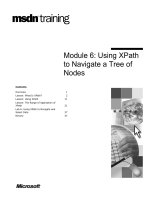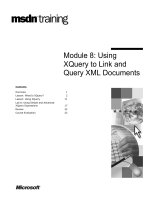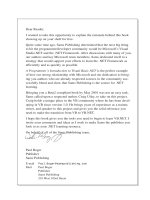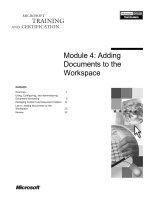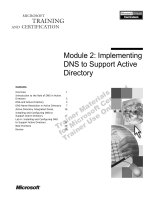Tài liệu Instant Galleria How-to Recipes to make you an expert user of the Galleria JavaScript framework ppt
Bạn đang xem bản rút gọn của tài liệu. Xem và tải ngay bản đầy đủ của tài liệu tại đây (915.61 KB, 70 trang )
www.it-ebooks.info
Instant Galleria
How-to
Recipes to make you an expert user of the
Galleria JavaScript framework
Nathan Van Gheem
BIRMINGHAM - MUMBAI
www.it-ebooks.info
Instant Galleria How-to
Copyright © 2013 Packt Publishing
All rights reserved. No part of this book may be reproduced, stored in a retrieval system, or
transmitted in any form or by any means, without the prior written permission of the publisher,
except in the case of brief quotations embedded in critical articles or reviews.
Every effort has been made in the preparation of this book to ensure the accuracy of the
information presented. However, the information contained in this book is sold without
warranty, either express or implied. Neither the author, nor Packt Publishing, and its dealers
and distributors will be held liable for any damages caused or alleged to be caused directly
or indirectly by this book.
Packt Publishing has endeavored to provide trademark information about all of the companies
and products mentioned in this book by the appropriate use of capitals. However, Packt
Publishing cannot guarantee the accuracy of this information.
First published: February 2013
Production Reference: 1080213
Published by Packt Publishing Ltd.
Livery Place
35 Livery Street
Birmingham B3 2PB, UK.
ISBN 978-1-84969-660-9
www.packtpub.com
www.it-ebooks.info
Credits
Author
Project Coordinator
Nathan Van Gheem
Reviewer
Esha Thakker
Proofreader
Victor Berchet
Lawrence A. Herman
Acquisition Editor
Production Coordinator
Usha Iyer
Conidon Miranda
Commissioning Editor
Ameya Sawant
Technical Editor
Kirti Pujari
Cover Work
Conidon Miranda
Cover Image
Conidon Miranda
www.it-ebooks.info
About the Author
Nathan Van Gheem primarily works on Python web solutions. He also has extensive
experience with JavaScript and integrating JavaScript solutions in web applications. He
is involved with the Plone Python CMS open source community where he is the UI team
leader and is on the Security team.
I would like to thank my family for the sacrifice of time they put up with,
Wildcard Corp for giving me an opportunity to work on interesting projects,
and Kim Nguyen for encouraging and enabling me to challenge myself with
open source software.
www.it-ebooks.info
About the Reviewer
Victor Berchet was introduced to web development in 2007 by playing with Google Maps,
JavaScript API, and PHP, after having spent 10 years in the domain of embedded software
development. He became a freelance Web Engineer in 2010 by founding Suumit, his own
company. Most of the projects Victor works on involve either JavaScript mapping or the
Symfony2 PHP framework. He is pretty much engaged in open source software and is
one of the top contributors of Symfony2.
www.it-ebooks.info
www.PacktPub.com
Support files, eBooks, discount offers and more
You might want to visit www.PacktPub.com for support files and downloads related to
your book.
Did you know that Packt offers eBook versions of every book published, with PDF and ePub
files available? You can upgrade to the eBook version at www.PacktPub.com and as a print
book customer, you are entitled to a discount on the eBook copy. Get in touch with us at
for more details.
At www.PacktPub.com, you can also read a collection of free technical articles, sign up for
a range of free newsletters and receive exclusive discounts and offers on Packt books and
eBooks.
TM
Do you need instant solutions to your IT questions? PacktLib is Packt’s online digital book
library. Here, you can access, read and search across Packt’s entire library of books.
Why Subscribe?
ff
Fully searchable across every book published by Packt
ff
Copy and paste, print and bookmark content
ff
On demand and accessible via web browser
Free Access for Packt account holders
If you have an account with Packt at www.PacktPub.com, you can use this to access
PacktLib today and view nine entirely free books. Simply use your login credentials for
immediate access.
www.it-ebooks.info
Table of Contents
Preface1
Galleria How-to
7
Setting up the development environment (Simple)
Your first gallery (Simple)
Configuring Galleria (Simple)
Installing themes (Simple)
Creating your own theme (Medium)
Creating mobile friendly themes (Simple)
Installing plugins (Simple)
Using the Flickr plugin (Medium)
Creating a plugin (Advanced)
Using the API (Medium)
Alternative image data structures (Simple)
Optimizing Galleria (Simple)
Adding images dynamically (Medium)
Triggering Galleria (Advanced)
Recording image views with Google Analytics (Medium)
Handling errors gracefully (Medium)
Creating tests for customizations (Advanced)
Web application integration (Advanced)
www.it-ebooks.info
7
9
12
14
15
20
23
24
27
30
35
40
41
44
46
48
50
54
www.it-ebooks.info
Preface
Galleria is a JavaScript framework for building beautiful image galleries for the web. It comes
packed with responsive web design support and swipe for mobile devices. With its flexible
theming system, you'll be able to customize it to your needs or you can use one of the many
available themes. It is open sourced under the MIT license and comes packed with a free
classic theme. Galleria has a large user base with many web application add-ons already
provided on various platforms. It's an obvious choice for creating beautifully customized
galleries on your website.
If you want to integrate Galleria to create your own beautiful image galleries for the web,
Galleria How-to is the book you need.
Using concise recipes, Galleria How-to will take you from creating and configuring your
first gallery to creating themes and plugins, using the Galleria API and integrating with
web applications.
What this book covers
Setting up the development environment (Simple) details how to set up a development
environment to start developing with Galleria.
Your first gallery (Simple) introduces creating a simple gallery.
Configuring Galleria (Simple) details how to configure Galleria with JavaScript and
HTML attributes.
Installing themes (Simple) discusses how to install and use different themes.
Creating your own theme (Medium) details the process of creating custom themes
with JavaScript and CSS.
Creating mobile friendly themes (Simple) introduces how to create mobile friendly
themes using responsive web design.
www.it-ebooks.info
Preface
Installing plugins (Simple) details how to install and use plugins.
Using the Flickr plugin (Medium) goes more in depth with using plugins by configuring and
customizing the use of the flickr plugin.
Creating a plugin (Advanced) discusses in-depth how to create a plugin from scratch.
Using the API (Medium) details taking full control of Galleria's API to customize its behavior.
Alternative image data structures (Simple) explains how to use different data structures and
mechanism to instruct Galleria on what images to use.
Optimizing Galleria (Simple) introduces how to improve your gallery and website performance.
Adding images dynamically (Medium) explains how to use JavaScript to incrementally add
images to galleries.
Triggering Galleria (Advanced) details triggering Galleria from events outside of the gallery.
Recording image views with Google Analytics (Medium) details how to track hits on images
in galleries to improve analytics.
Handling errors gracefully (Medium) explains how to handle gracefully potential problems
that could arise with Galleria.
Creating tests for customizations (Advanced) discusses creating tests on customizations for
quality assurance.
Web application integration (Advanced) details how to integrate Galleria with web applications
using a simple example in Python.
What you need for this book
To follow the recipes in this book, you will need a computer suitable for developing JavaScript,
HTML, and CSS. You may use Windows, Mac OS X, or Linux. You will need a modern web
browser with debugging tools such as Mozilla Firefox or Google Chrome, and a text editor.
We will cover setting up a development environment, including downloading of the Galleria
source code, in the first recipe of this book, Setting up the development environment.
Who this book is for
This book assumes the reader is comfortable reading and editing JavaScript, HTML, and CSS.
With a basic understanding of JavaScript, most of the book is very applicable. An in-depth
understanding of HTML and CSS is required throughout the book.
2
www.it-ebooks.info
Preface
Conventions
In this book, you will find a number of styles of text that distinguish between different kinds
of information. Here are some examples of these styles, and an explanation of their meaning.
Code words in text are shown as follows: "We can include other contexts through the use of
the include directive."
A block of code is set as follows:
$(document).ready(function(){
Galleria.loadTheme(
'../themes/classic/galleria.classic.min.js');
Galleria.run('#galleria');
});
When we wish to draw your attention to a particular part of a code block, the relevant lines
or items are set in bold:
Galleria.configure({
autoplay: true
});
Any command-line input or output is written as follows:
# cp /usr/src/asterisk-addons/configs/cdr_mysql.conf.sample
/etc/asterisk/cdr_mysql.conf
New terms and important words are shown in bold. Words that you see on the screen,
in menus or dialog boxes for example, appear in the text like this: "clicking the Next button
moves you to the next screen."
Warnings or important notes appear in a box like this.
Tips and tricks appear like this.
3
www.it-ebooks.info
Preface
Reader feedback
Feedback from our readers is always welcome. Let us know what you think about this
book—what you liked or may have disliked. Reader feedback is important for us to develop
titles that you really get the most out of.
To send us general feedback, simply send an e-mail to , and
mention the book title via the subject of your message.
If there is a topic that you have expertise in and you are interested in either writing or
contributing to a book, see our author guide on www.packtpub.com/authors.
Customer support
Now that you are the proud owner of a Packt book, we have a number of things to help you
to get the most from your purchase.
Downloading the example code
You can download the example code files for all Packt books you have purchased from your
account at . If you purchased this book elsewhere, you can
visit and register to have the files e-mailed
directly to you.
Errata
Although we have taken every care to ensure the accuracy of our content, mistakes
do happen. If you find a mistake in one of our books—maybe a mistake in the text or the
code—we would be grateful if you would report this to us. By doing so, you can save other
readers from frustration and help us improve subsequent versions of this book. If you find
any errata, please report them by visiting />selecting your book, clicking on the errata submission form link, and entering the details
of your errata. Once your errata are verified, your submission will be accepted and the errata
will be uploaded on our website, or added to any list of existing errata, under the Errata
section of that title. Any existing errata can be viewed by selecting your title from
/>
4
www.it-ebooks.info
Preface
Piracy
Piracy of copyright material on the Internet is an ongoing problem across all media. At Packt,
we take the protection of our copyright and licenses very seriously. If you come across any
illegal copies of our works, in any form, on the Internet, please provide us with the location
address or website name immediately so that we can pursue a remedy.
Please contact us at with a link to the suspected
pirated material.
We appreciate your help in protecting our authors, and our ability to bring you valuable content.
Questions
You can contact us at if you are having a problem with any
aspect of the book, and we will do our best to address it.
5
www.it-ebooks.info
www.it-ebooks.info
Galleria How-to
Welcome to Galleria How-to. This How-to will guide you to become an expert at utilizing the
Galleria gallery framework to make beautiful and functional galleries for websites that scale
to mobile platforms.
Setting up the development environment
(Simple)
This section will cover how to get prepared to start developing with Galleria. We'll install
and run Galleria with the classic theme, create the folder structure, and set up the
development environment.
Getting ready
Before we start developing with Galleria, you'll need a text editor to use throughout this
book since we'll be modifying HTML, JavaScript, and CSS.
How to do it...
1. First, you'll need to download the Galleria source code. In a web browser, visit
and download the latest Galleria source code.
At the time this book was written, Galleria was at Version 1.2.8.
2. Once the download is finished, extract it, and inspect the contents of the download.
3. We'll then add a new folder in the previous extracted source and name it
development. This is where we'll do all our Galleria development for the rest of
the book.
www.it-ebooks.info
Galleria How-to
4. Inside the development directory, we'll then create an images folder. Please
insert test images in this folder to use with the development galleries we'll create.
5. Once done, the contents of the Galleria source should look like the following
screenshot:
6. Next, let's test whether the downloaded Galleria source code is working properly or
not. Galleria comes with a free default theme called "classic". Navigate to themes/
classic/classic-demo.html and open the file in a modern web browser
(Google Chrome, Firefox, or Microsoft Internet Explorer version 8 or later), which
should result in the following gallery:
8
www.it-ebooks.info
Galleria How-to
Galleria components
Here, we'll cover that part of Galleria that provides the gallery functionality.
ff
galleria.js: This is the gallery script that loads images and facilitates the gallery
functionality.
ff
theme javascript: A theme consists of a combination of JavaScript, HTML, and
CSS to provide a unique load and feel.
ff
plugins: These plugins are used to extend and override the way galleria.js
works. For instance, there is a flickr plugin to get images from flickr and not from
the HTML DOM as that is used frequently.
If you don't have a text editor...
There are many great open source text editors that you can use to edit HTML, JavaScript,
and CSS. For Windows, Notepad++ is a great text editor. It can be found at http://
notepad-plus-plus.org/. For Mac OS X, TextWrangler is a very good free text editor
that can be found at />You are also free to use the default text editors that come with your operating system but
they're usually not as easy to use for development.
Extracting the source code
The Galleria source code download will come in a zipped archive format that is extractable on
most modern operating systems. If you have trouble extracting the source code for Windows,
use 7zip, available at Mac OS X should be able to extract all
archive types you come across.
Your first gallery (Simple)
In this recipe, we're going to go through the basics of creating a Galleria gallery. HTML
structure and Galleria JavaScript are topics that will be covered in this recipe.
Getting ready
Assemble together a group of images that you'll use while working with Galleria and place
them into your Galleria development image source directory (galleria/development/
images).
9
www.it-ebooks.info
Galleria How-to
How to do it...
1. Create a myfirstgallery.html file inside the development folder.
2. Start off with the usual HTML5 doctype structure.
3. Inside the head section include the JavaScript dependencies, jquery.js
and galleria.js. In both the cases, we'll use the following minified versions:
<!DOCTYPE html>
<html lang="en">
<head>
<script src=" /></script>
<script src="../galleria-1.2.8.min.js"></script>
/* end of Javascript file includes */
Make sure the relative path used to reference galleria.js is correct for the
folder structure being used.
Downloading the example code
You can download the example code files for all Packt books you have
purchased from your account at . If you
purchased this book elsewhere, you can visit ktPub.
com/support and register to have the files e-mailed directly to you.
4. Next, we'll need to provide the following code to initialize the gallery:
/* end of Javascript file includes */
<script>
$(document).ready(function(){
Galleria.loadTheme(
'../themes/classic/galleria.classic.min.js');
Galleria.run('#galleria');
});
</script>
</head>
/* end of head tag */
10
www.it-ebooks.info
Galleria How-to
Here, $(document).ready is a jQuery construct used to run the
code inside the anonymous function after the document is ready. This is
important because we need to load the gallery after all the images are
loaded in the DOM.
The Galleria.loadTheme function loads the theme file. It takes only
one parameter, the path of the JavaScript file.
Finally, the Galleria.run function is used to wire a gallery up via a CSS
selector. In this case, #galleria refers to a tag with the ID of "galleria"
that we'll define later.
5. Next, we'll add references to the images we want to provide in the gallery. The
standard way to do this, demonstrated here, is to provide them through an HTML
structure. The basic structure is to provide the full size image as the href attribute
of an anchor tag. The thumbnail image is defined via an img tag. If you have
not generated thumbnails, just use your full size image for the thumbnail.
6. Inside the body tag, we'll provide the following HTML code to reference the images
for our gallery:
<body>
<div id="galleria" style="height: 500px;">
<a href="images/image1-1600px.jpg">
src="images/image1-200px.jpg" />
</a>
</div>
</body>
The id="galleria" attribute and value refers to what we were using with
the Galleria.run method to instruct Galleria where to look for the images
The style="height: 500px;" attribute and value gives a height to the
gallery, which is required for Galleria to function
The data-title attribute is where we can give our image a title that the
theme will use
Finally, the data-description attribute, similar to the title attribute,
gives the image a description to be shown in the gallery
11
www.it-ebooks.info
Galleria How-to
How it works...
Galleria searches the div tag with the id "galleria" to find images to load the gallery.
Galleria then calls the theme JavaScript initialization code to generate additional HTML and
JavaScript events that set up the gallery further. Essentially, galleria.js provides the basic
gallery components and the theme uses these components to further customize the look and
feel of the gallery.
Defining a height
It is important to define a height for all Galleria galleries. If no height is defined in CSS or a
style tag, the gallery will fail to load.
Data attributes
In this example, we use data attributes, which are attributes that start with "data-", to define
the title and description of the image. We could have just as easily specified title and alt
attributes that would also populate the title and description values. Either way works the same.
Configuring Galleria (Simple)
In this recipe, we'll learn how to get more out of Galleria by knowing how to turn the knobs
that will customize the gallery in different ways.
Getting ready
In this example, please utilize the code we wrote in the first How to do it... section, or work
with the themes/classic/classic-demo.html file. Both will allow us to manipulate
configuration options.
How to do it...
To configure Galleria, we'll use the Galleria.configure method. This method accepts
a JavaScript object of keys and values.
Galleria.configure({
autoplay: true
});
In this example, we're invoking Galleria to automatically start the gallery when the page
is loaded with the autoplay option.
12
www.it-ebooks.info
Galleria How-to
How it works...
The JavaScript object passed into the Galleria.configure method overrides or extends
the default Galleria configuration. This configuration is then passed on to the theme loaded
and plugins that are installed.
There's more...
We can also combine the Galleria.run method call with configuration options. Using the
example we've been working with, the Galleria.run method call would look as follows:
Galleria.run('#galleria', {autoplay: true});
Useful configuration options
Here, we'll cover the most useful Galleria configuration options.
ff
autoplay: This option automatically starts the gallery on page load. Its default
value is set to false.
ff
carousel: This option controls whether a carousel is created. Its default value
is set to true.
ff
carouselSpeed: This option controls the animation speed of changes in the
carousel in milliseconds. Its default value is set to 200.
ff
height: This option manually sets the gallery height. This is useful if no height is
set in CSS. Its default value is set to 0.
ff
width: This option manually sets the gallery width. This is useful if no width is set
in CSS and constraining the gallery width is required. Its default value is set to 0.
ff
transition: This option customizes the transition used for changing images.
It defaults to "fade" for most themes but is "slide" for the classic theme.
ff
transitionSpeed: This option customizes the duration of the transition. Its
default value is set to 400 milliseconds.
ff
preload: This option provides the number of images to preload in the gallery.
It defaults to 2.
ff
responsive: This option tells Galleria to resize when the window size changes.
This will only work along with media queries that define how the gallery should
look with different window sizes. Its default value is set to false.
ff
show: This option customizes which image should be displayed first. It defaults
to 0 (first image).
ff
showInfo: This option shows the caption information. It defaults to true.
13
www.it-ebooks.info
Galleria How-to
ff
thumbnails: This option customizes how the thumbnails are generated.
The following are the possible values for this option:
true: This value shows thumbnail images
false: This value does not show the thumbnail browser
"empty": This value places empty span tags with the class of "img"
"numbers": This value places empty span tags with numbers instead
of images
All of these options are also defined in the Galleria source code and on Galleria's
website documentation.
Complete listing of options
Visit for a complete listing of Galleria options.
Installing themes (Simple)
Installing different themes will allow us to give Galleria a different look and feel, and in this
recipe we will explore how we can use themes and install them.
Getting ready
The theme we'll be working with is the classic theme that comes with the Galleria source code.
How to do it...
There are two ways by which we can load theme files into Galleria:
1. The first is to use the Galleria API to load the theme JavaScript file:
Galleria.loadTheme('../themes/classic/galleria.classic.min.js');
The only parameter the loadTheme function takes is a string that is the relative
path to the theme JavaScript file.
2. The second way to load the theme JavaScript file is simply to include the JavaScript
file via the script tag as follows:
<script src="../themes/classic/galleria.classic.min.js">
</script>
The theme JavaScript file needs to be loaded before the Galleria.run function in order
to start Galleria with the theme loaded.
14
www.it-ebooks.info
Galleria How-to
How it works...
The theme file will automatically load dependent CSS files required for the theme. It will
additionally run initialization code for theme specific look and feel.
There's more...
It's possible to dynamically change Galleria themes by loading other themes with the
Galleria.loadTheme function.
Downloading Galleria themes
Galleria only comes with one free theme, the Classic theme, which comes with the Galleria
source code. Other themes can be found at />As of the writing of this book, there are no other useful sources for themes for Galleria.
Sparse references to themes can be found in some github projects and also in some CMS
Galleria integration packages. However, it's not easy to know how to use these themes
without some customization, so we won't cover them in this book.
Creating your own theme (Medium)
Creating your own theme will allow you to customize Galleria in a very simple format. Here
we will also introduce the structure for creating a basic theme.
Getting ready
In order to keep all the theme related files together, create a new folder inside the development
folder named themes. Within the new themes folder, create another folder named basic.
After this is done, our folder structure should be identical to the following screenshot:
15
www.it-ebooks.info
Galleria How-to
Lastly, create empty galleria.basic.js, galleria.basic.css, and galleria.
basic-example.html files inside the basic folder that was just created. Then, copy the
contents of the myfirstgallery.html file and insert the text into the galleria.basicexample.html file. These are the files that we will be customizing in this recipe.
How to do it...
1. First, let's create the skeleton for our basic galleria theme in the galleria.basic.
js file:
(function($) {
Galleria.addTheme({
name: 'basic',
author: 'Galleria How-to',
css: 'galleria.basic.css',
defaults: { transition: 'slide' },
init: function(options) {
}
});
}(jQuery));
The addTheme function registers the theme with the provided settings to Galleria.
The .css file specified with the css option is automatically loaded here also. The
init anonymous function is empty right now but this is where we would put the
custom JavaScript functionality.
2. Next, we'll go on to styling our gallery. At its basic level, this involves placing tags
into the DOM so that they can be positioned on the page.
The major components of the gallery that need to be styled are:
#galleria-loader
.galleria-info
.galleria-stage
.galleria-thumbnails-container
.galleria-counter
.galleria-image-nav
Now, let's go through the contents of the CSS file that provides very basic styles
for our gallery.
#galleria{ height: 550px; }
16
www.it-ebooks.info


